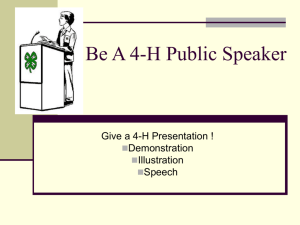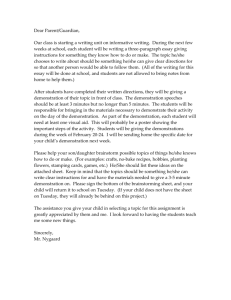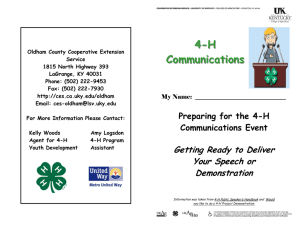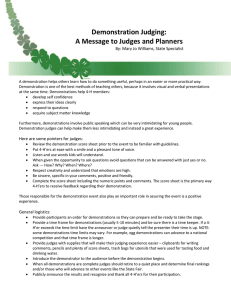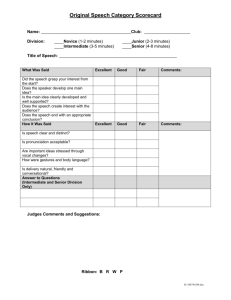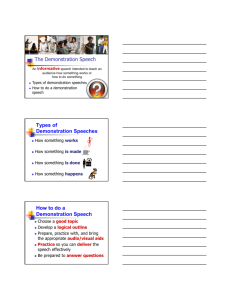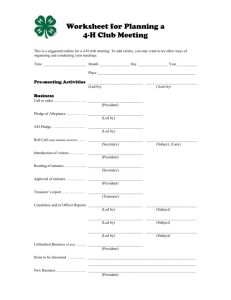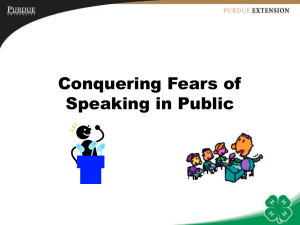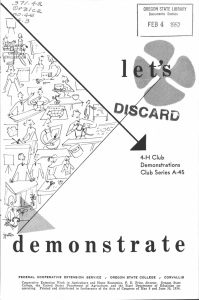working with a moving audience - NYS 4-H
advertisement
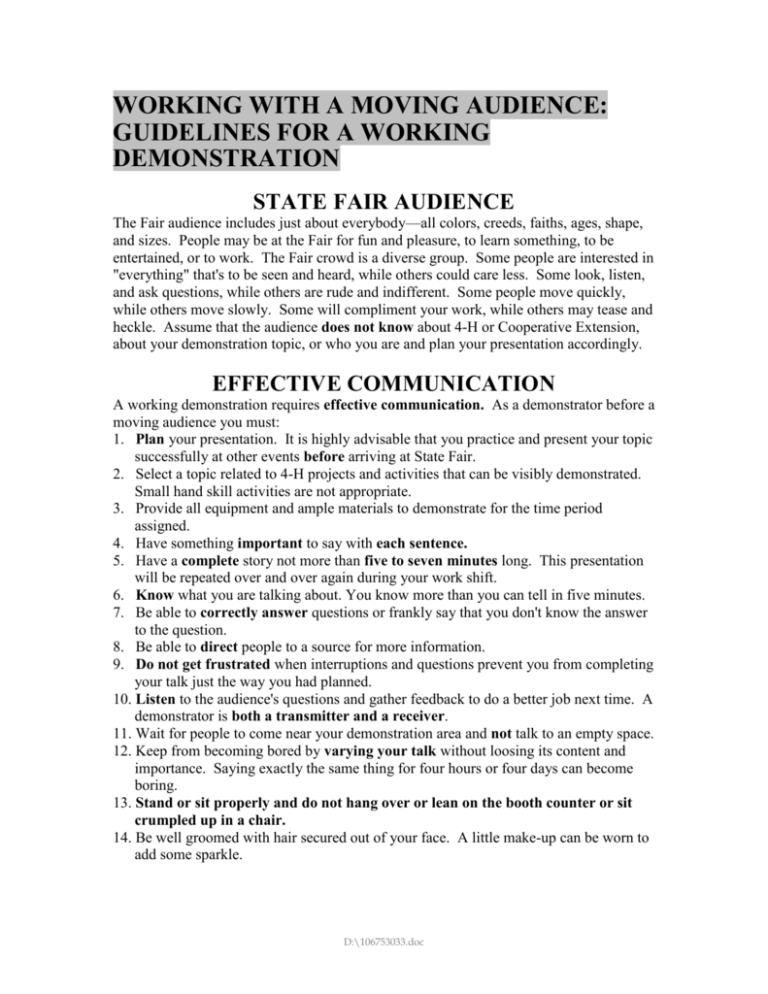
WORKING WITH A MOVING AUDIENCE: GUIDELINES FOR A WORKING DEMONSTRATION STATE FAIR AUDIENCE The Fair audience includes just about everybody—all colors, creeds, faiths, ages, shape, and sizes. People may be at the Fair for fun and pleasure, to learn something, to be entertained, or to work. The Fair crowd is a diverse group. Some people are interested in "everything" that's to be seen and heard, while others could care less. Some look, listen, and ask questions, while others are rude and indifferent. Some people move quickly, while others move slowly. Some will compliment your work, while others may tease and heckle. Assume that the audience does not know about 4-H or Cooperative Extension, about your demonstration topic, or who you are and plan your presentation accordingly. EFFECTIVE COMMUNICATION A working demonstration requires effective communication. As a demonstrator before a moving audience you must: 1. Plan your presentation. It is highly advisable that you practice and present your topic successfully at other events before arriving at State Fair. 2. Select a topic related to 4-H projects and activities that can be visibly demonstrated. Small hand skill activities are not appropriate. 3. Provide all equipment and ample materials to demonstrate for the time period assigned. 4. Have something important to say with each sentence. 5. Have a complete story not more than five to seven minutes long. This presentation will be repeated over and over again during your work shift. 6. Know what you are talking about. You know more than you can tell in five minutes. 7. Be able to correctly answer questions or frankly say that you don't know the answer to the question. 8. Be able to direct people to a source for more information. 9. Do not get frustrated when interruptions and questions prevent you from completing your talk just the way you had planned. 10. Listen to the audience's questions and gather feedback to do a better job next time. A demonstrator is both a transmitter and a receiver. 11. Wait for people to come near your demonstration area and not talk to an empty space. 12. Keep from becoming bored by varying your talk without loosing its content and importance. Saying exactly the same thing for four hours or four days can become boring. 13. Stand or sit properly and do not hang over or lean on the booth counter or sit crumpled up in a chair. 14. Be well groomed with hair secured out of your face. A little make-up can be worn to add some sparkle. D:\106753033.doc 15. Wear neat and comfortable clothes and shoes. Stand tall as you represent your 4-H club, the New York State 4-H Youth Development Program, and Cornell Cooperative Extension. WORKING DEMONSTRATION OBJECTIVES: By doing your working demonstration you provide the audience with information. You INFORM the audience by educating them about your project or experience. You PERSUADE the audience by helping them to develop positive attitudes about your project or experience by reinforcing positive attitudes and behavior. ATTENTION In order to get the audience's attention, it will be necessary for you to distract people from their current thoughts by trying some of the following: 1. Ask them a direct question about something which concerns them relating to your topic. 2. Look them straight in the eye and smile. 3. Introduce yourself, and say "Hi!" "Hello!" "Good Morning!" or "Good Afternoon!" 4. Have another booth worker engage them in conversation and bring them to the booth. You must get the attention of the audience or it's a wasted effort. INTEREST You hold the audience's interest by: 1. Speaking convincingly and with a clear, strong voice. 2. Being interested in what you are saying. 3. Using visual aids. Prepare signs and posters that can be read from a distance of 10 feet. 4. Using a slide, filmstrip, or a movie projector to help communicate your message. 5. Appealing to people's senses with a display of the project. Being able to see, and sometimes handle the finished product makes a great impact. DESIRE You arouse the audience's desire and liking. You make a persuasive effort by explaining specifically how the item or experience can be used, made, or enjoyed by the individual or why the individual should be interested in the topic. ACTION You obtain the audience's action by summarizing your important points. You try to affect the audience's behavior by having them request directions for the project, ask for more information, or try their hand at the project, etc. You should bring at least 350 copies of project directions to the Fair, if appropriate, or a listing of where to get more information on the subject. Prepared by: Linda E. Dorr, Montgomery County Cooperative Extension Agent. Revised 3/93 (Sources: Clark E. Garner (Assoc. Prof., DEA), "Working With a Moving Audience"; E. Jerome McCarthy, Basic Marketing, (Illinois: Richard D. Irwin, Inc., 1978). D:\106753033.doc
